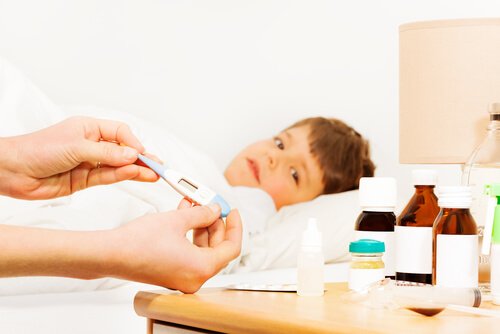How to Naturally Check for a Fever in Children

Children frequently complain that they don’t feel well. Most of the time, it’s because they have a high body temperature. This can catch you off guard if you don’t have a thermometer on hand. In this article, we’ll show you how to naturally check for a fever in children.
Certainly, every mother should know that there are some natural methods that help you know if your child’s temperature is a little higher than normal. However, none of these tips are as reliable as a thermometer.
How to naturally check for a fever in children
Here are some ways to naturally check for a fever in children:
1. Put your hand on their forehead
First of all, you should know that with a fever, their skin feels warm to the touch. Therefore, you can place your hand on children’s foreheads or another part of their body. When they have a fever, they have an increase in body temperature.
If your child has a fever, he’ll be noticeably warmer than normal. In fact, his forehead might be clammy or wet with sweat.
However, one study has confirmed that touching it could actually make you overestimate if there’s a fever. However, the good thing is that you’re rarely off by a few tenths or more.

2. Dehydration
Another way to naturally check for a fever is to see whether or not they’re thirsty or have a dry mouth. People with a fever face a high risk of dehydration. Similarly, the color of their urine can also help determine if they’re dehydrated and have a fever.
Therefore, keep in mind that if you notice that your child’s urine is really yellow, it may be a sign that he’s dehydrated and may have a fever. On the contrary, urine that’s darker than usual can also mean a high body temperature.
“First of all, you should know that with a fever, children’s skin feels warm to the touch. Therefore, you can place your hand on their forehead or another part of the body.”
3. Skin color to naturally check for a fever
In general, an increase in body temperature from a fever makes your skin turn red, especially in your cheeks. However, keep in mind that if your child has darker skin, it might be difficult to tell if it’s red or not.
4. Heart rate
Fourth, heart rate is another way to measure fever without using a thermometer. By taking children’s pulse, you can naturally check for a fever.
Of course, you should think about your child’s normal heart rate. In addition, you should know that children with a fever generally have a higher heart rate. Without a doubt, this is one of the most reliable ways to know if your child has a fever.
Tips for naturally checking for a fever by touching the forehead or neck
Touch is the most common natural method to check if your child has a fever or not. This procedure is very simple, and all you have to do is touch your child’s forehead or neck to see if it’s warmer than normal.
In any case, there are some things you need to consider. That way, you can be sure to do it correctly.
- Always use the palm of your hand. The skin on this part of your hand isn’t as sensitive as other areas.
- Don’t touch your child’s hands or feet to naturally check for a fever. His body’s extremities might be cold even when he has a high temperature.

- However, the feeling of heat doesn’t always mean that your child has a fever. In fact, sometimes your child’s skin can be very warm even though he’s in perfect health. On the other hand, sometimes your child may have a fever when his skin is cool to the touch.
- Make sure to check your child’s temperature when you’re in a room at room temperature that’s not too hot and not too cold. Similarly, don’t try this technique on children after they play sports.
Finally, remember that these methods aren’t always reliable. Therefore, we recommend using a thermometer as the most reliable way to know for sure. In any case, if you think your child has a fever, the most important thing is to consult your doctor.
Children frequently complain that they don’t feel well. Most of the time, it’s because they have a high body temperature. This can catch you off guard if you don’t have a thermometer on hand. In this article, we’ll show you how to naturally check for a fever in children.
Certainly, every mother should know that there are some natural methods that help you know if your child’s temperature is a little higher than normal. However, none of these tips are as reliable as a thermometer.
How to naturally check for a fever in children
Here are some ways to naturally check for a fever in children:
1. Put your hand on their forehead
First of all, you should know that with a fever, their skin feels warm to the touch. Therefore, you can place your hand on children’s foreheads or another part of their body. When they have a fever, they have an increase in body temperature.
If your child has a fever, he’ll be noticeably warmer than normal. In fact, his forehead might be clammy or wet with sweat.
However, one study has confirmed that touching it could actually make you overestimate if there’s a fever. However, the good thing is that you’re rarely off by a few tenths or more.

2. Dehydration
Another way to naturally check for a fever is to see whether or not they’re thirsty or have a dry mouth. People with a fever face a high risk of dehydration. Similarly, the color of their urine can also help determine if they’re dehydrated and have a fever.
Therefore, keep in mind that if you notice that your child’s urine is really yellow, it may be a sign that he’s dehydrated and may have a fever. On the contrary, urine that’s darker than usual can also mean a high body temperature.
“First of all, you should know that with a fever, children’s skin feels warm to the touch. Therefore, you can place your hand on their forehead or another part of the body.”
3. Skin color to naturally check for a fever
In general, an increase in body temperature from a fever makes your skin turn red, especially in your cheeks. However, keep in mind that if your child has darker skin, it might be difficult to tell if it’s red or not.
4. Heart rate
Fourth, heart rate is another way to measure fever without using a thermometer. By taking children’s pulse, you can naturally check for a fever.
Of course, you should think about your child’s normal heart rate. In addition, you should know that children with a fever generally have a higher heart rate. Without a doubt, this is one of the most reliable ways to know if your child has a fever.
Tips for naturally checking for a fever by touching the forehead or neck
Touch is the most common natural method to check if your child has a fever or not. This procedure is very simple, and all you have to do is touch your child’s forehead or neck to see if it’s warmer than normal.
In any case, there are some things you need to consider. That way, you can be sure to do it correctly.
- Always use the palm of your hand. The skin on this part of your hand isn’t as sensitive as other areas.
- Don’t touch your child’s hands or feet to naturally check for a fever. His body’s extremities might be cold even when he has a high temperature.

- However, the feeling of heat doesn’t always mean that your child has a fever. In fact, sometimes your child’s skin can be very warm even though he’s in perfect health. On the other hand, sometimes your child may have a fever when his skin is cool to the touch.
- Make sure to check your child’s temperature when you’re in a room at room temperature that’s not too hot and not too cold. Similarly, don’t try this technique on children after they play sports.
Finally, remember that these methods aren’t always reliable. Therefore, we recommend using a thermometer as the most reliable way to know for sure. In any case, if you think your child has a fever, the most important thing is to consult your doctor.
This text is provided for informational purposes only and does not replace consultation with a professional. If in doubt, consult your specialist.








